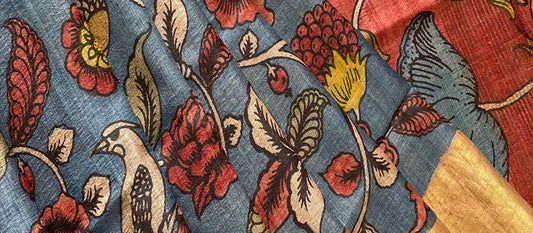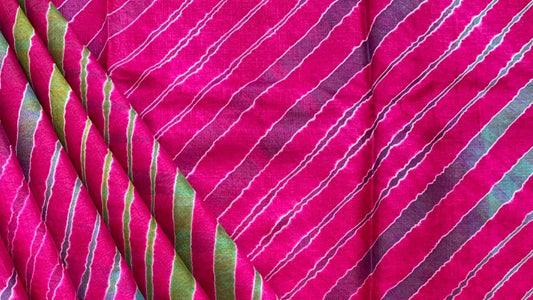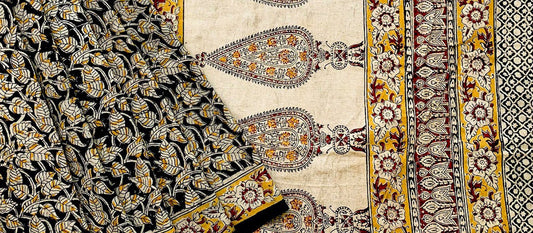
Karvati Kinar - Vidarbha Sarees
Karvati Kinar Vidarbha sarees are iconic and originated from the Vidarbha region of Maharastra showcasing the rich tradition and craftsmanship of India. With the use of natural tussar and unique three shuttle weaving technique, these sarees stand out from the other silk sarees in the global market.
Origin
In the past, 20s cotton yarn was used by handloom weavers in the villages of Andhalgaon, Mohadi, and Palandur District Bhandara, which are located in the Vidarbha area of Maharashtra, to manufacture cotton gamchha on two sides of the Karvati border (temple/saw tooth border with dobby patterns). The word "Karvat" in Marathi refers to a saw, while “Kinar” means border or edge therefore the sarees came to be called Karvati or Karvat-kati. District Bhandara is a region that produces tussar cocoons. Because they have an abundance of raw materials, the weavers used tussar material to weave the Tussar Karvati Saree.
The Tussar Silk is made of wild, natural silk that is harvested from a wide-winged, yellowish-brown moth. Because of the special environmental conditions in the Vidarbha region of Maharashtra State, Tussar produced there is thought to be the best in terms of quality and color. Traditionally, the task of guarding cocoons on forest trees has been performed primarily by indigenous people. After that, Tussar yarn is obtained and used to make sarees.
Weaving Technique
A Karvati Kinar Vidarbha Saree's body and border are often in complimenting colors and is produced with three-shuttle weaving, a type of tapestry weaving technique. The border is woven with dyed mercerized cotton yarn, while the body is woven with cream-colored handspun raw Tussar yarn. This saree is woven on pit looms that have a Nagpuri wooden lattice dobby installed above the weaver's seat at the top of the loom.
Our senior weaver artisan in action.

Design
The Karvati Kinar Vidarbha Saree is distinctive due to its border, which features saw tooth-like temple motifs woven in a range of sizes, and conventional motifs woven with extra warp threads regulated by a lattice dobby lending them a unique appeal.
Some of our exclusive Karvati Sarees

|
 |
Colors
The Karvati Kinar Vidharbha Saree mostly is woven in natural raw silk color body with stunning contrast borders in myriad colors. The pallu usually boasts of stripe pattern in complementing colors from the borders.
Very few extremely skilled master weavers also engage in weaving special karvat kinar sarees with check or stripe or buta motifs in the body area. This may often be further uplifted by weaving intricate motifs into the Jala pallu. Each saree takes almost 2-3 weeks to weave and is truly a classic representation of the rich Indian Handloom Heritage.
There are fewer and fewer craftspeople as a result of the forced migration of many weavers to other fields. Understanding the need to keep this skill alive, the Maharashtra State government has launched efforts to bring the ailing Karvati silk industry back to life. Redirecting over a thousand weavers back to their origins has given them a fresh chance.
When you envelop yourself in the gentle folds of a Karvati Kinar - Vidarbha Saree from vemshala.com, you’re not merely donning a garment; you’re becoming a living testament to the opulent cultural heritage and artistic lineage of Vidarbha. Explore the captivating allure of Vidarbha Karvati Sarees at vemshala.com, where tradition seamlessly intertwines with contemporary elegance.




